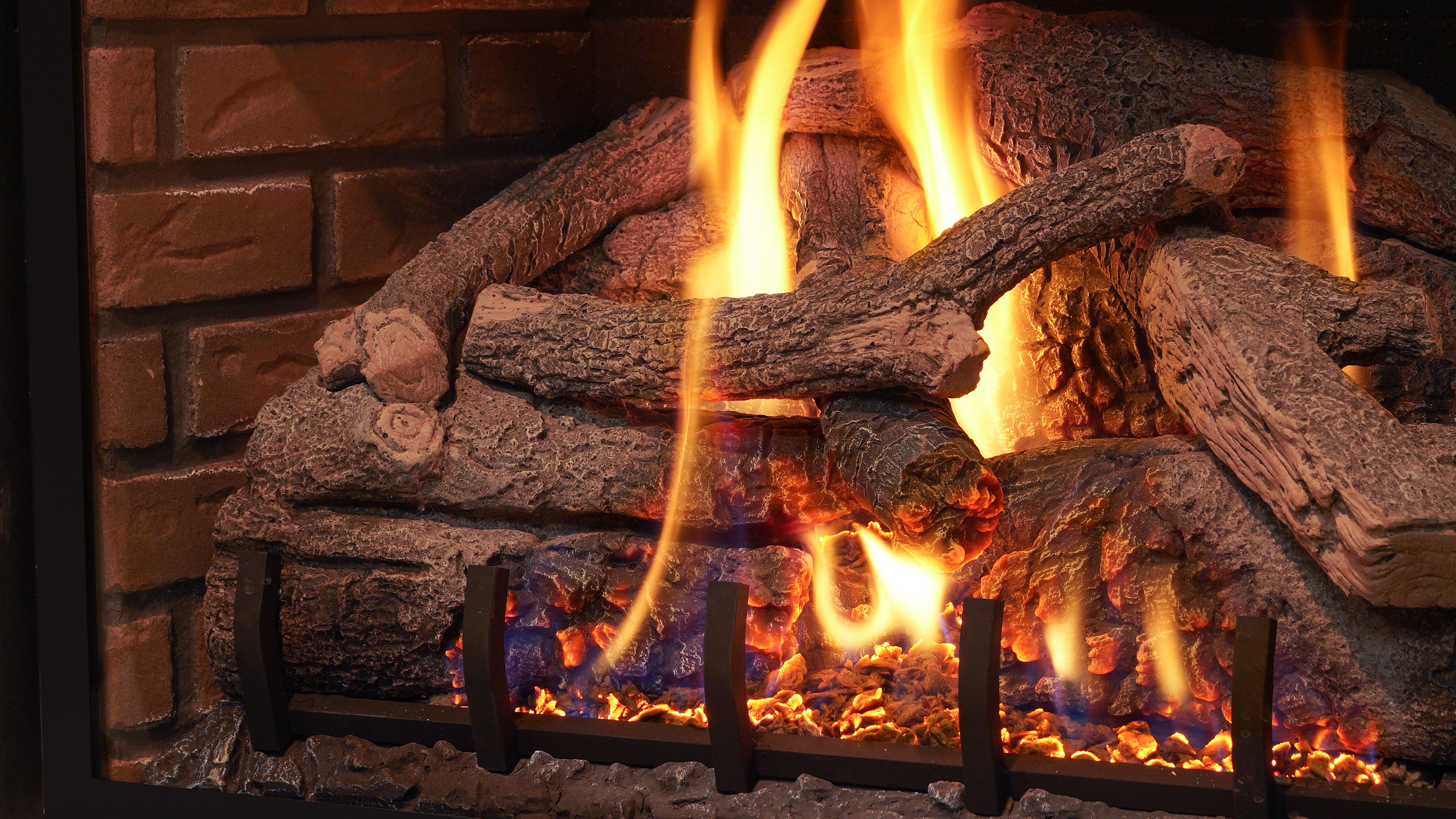By: Tom Regis, NFI Certified Master Hearth Professional
Last Updated: October 6, 2025
While gas appliances don’t require as much maintenance as wood burning units, it’s still important to inspect and clean your gas log set regularly.
Gas logs can collect dust and debris, especially during the warm summer months when you aren’t using your fireplace often. If left unchecked, the dust can clog components, corrode the finish on your logs, and cause an unpleasant odor when you reignite your fireplace.
Maintaining your gas fireplace and gas logs is essential for safe operation, efficient performance, and preserving the cozy ambiance they provide. Regular cleaning helps prevent issues like carbon monoxide buildup, gas leaks, and blockages in the venting system.
This step-by-step guide will walk you through the cleaning process, safety precautions, and when to seek professional inspection.
In This Article
- Step 1: Turning Off the Gas
- Step 2: Taking Your Gas Log Set Apart
- Step 3: Cleaning Your Logs and Firebox
- Step 4: Putting Your Gas Log Set Back Together
- Step 5: Turning the Gas Back On
- Step 6: Scheduling a Professional Inspection
- Step 7: Performing Regular Maintenance
- Additional Tips for Homeowners
- Gas Log FAQs
Step 1: Turn Off Your Gas Supply
Before you start disassembling your gas log set, ensure the gas valve is switched off.
Confirm that the pilot light is extinguished and wait at least 10 minutes to allow any residual gas to leave the gas line safely. This precaution is vital to prevent gas leaks and ensure safe operation.
If you recently used your fireplace, let your gas log set cool completely before you handle it.
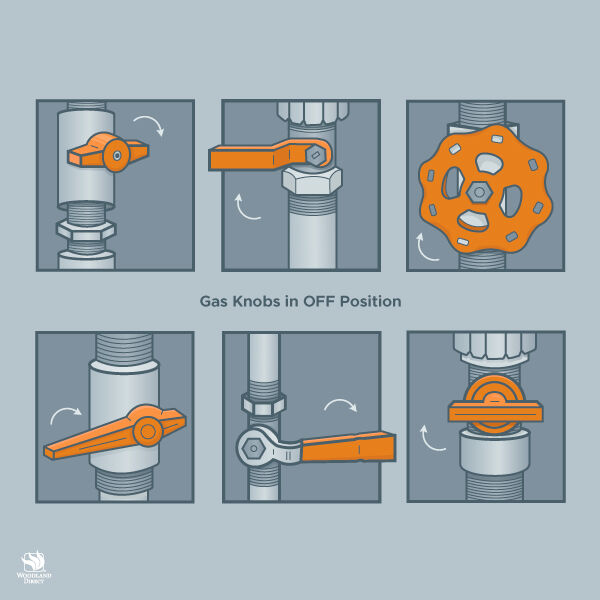
Step 2: Remove and Inspect Your Gas Logs
Carefully remove your gas fireplace logs from the firebox one at a time wearing a pair of heavy-duty work gloves to protect your hands.
Some log sets feature intricate details and delicate textures that resemble real wood, so you’ll want to handle them carefully. You may also want to consider laying the logs on top of newspapers, a small tarp, or an old bed sheet, so they don't leave soot on your floors or furniture.
As you remove each log, inspect it for cracks, chips, dents, or other signs of wear. Damaged logs can affect airflow and lead to inefficient operation or safety hazards. Replace any compromised logs before reassembling the set in your fireplace.
Do not disconnect or remove the burner system in your gas fireplace. It's best to hire a professional to clean your gas lines and burner assembly, otherwise you run the risk of reassembling the system incorrectly and creating a fire hazard in your home.

Step 3: Clean Your Log Set and Firebox
Once you’re ready to start cleaning your log set, you’ll first need to determine if it’s made of ceramic fiber or refractory ceramic materials.
Ceramic Fiber Gas Log Sets
Ceramic fiber gas log sets are very lightweight and feel like foam when handled, so you’ll need to be extra careful with them. With ceramic fiber logs, it’s best to use a dry cleaning method that prevents water from seeping into the porous surface.
Take your ceramic fiber logs outside and use a soft-bristled brush or brush attachment on a vacuum cleaner to gently remove soot and debris. When you're finished brushing them, use a can of compressed air on the surface of the logs to blow away any remaining debris.

Refractory Ceramic Gas Log Sets
Often used in Direct Vent gas fireplaces, refractory ceramic gas log sets are sturdier, have a smooth surface, and won't absorb water. For refractory ceramic logs, you'll need to use a wet cleaning method.
Take your refractory ceramic logs outside and fill a spray bottle or bucket of water with one part water and one part dish soap. Dampen your log set with plain water, then use a clean, coarse cloth to lightly scrub the surface of each log with your mixture.
Since most refractory ceramic log sets are hand-painted, you’ll want to scrub rigorously enough to remove soot and debris, but not hard enough to chip the paint.
After you’re done scrubbing, let the cleaning mixture sit on your logs for about five minutes and rinse them off with water.
Let your gas log set dry completely before putting it back into your fireplace.
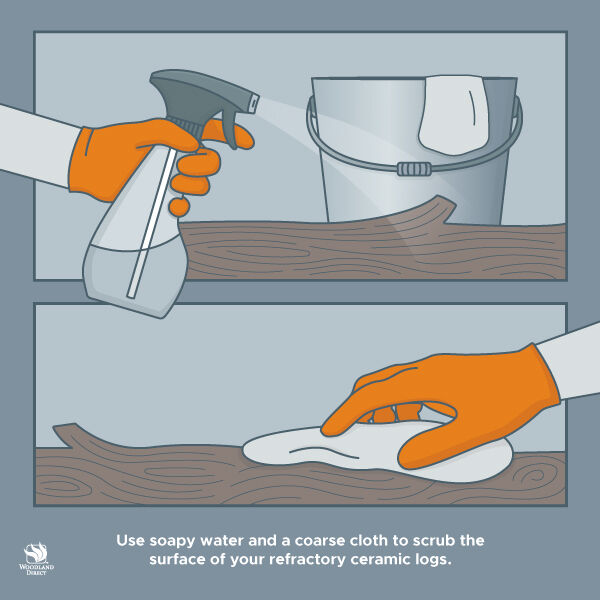
Clean Your Firebox
Now, it’s time to deep clean the firebox itself. Use a vacuum to clean out dust, debris, and cobwebs from the firebox floor and walls. The brush attachment will help you reach the corners and crevices.
If applicable, a fireplace glass cleaner and soft cloth can be used to wipe down glass doors, ensuring a clear view of the flames.
Step 4: Reassemble Your Log Set
Refer to the manufacturer’s instructions in your owner’s manual to correctly position your gas logs.
Proper placement is important, especially for Ventless or Vent-Free gas logs, which must be arranged in a specific pattern to work safely and prevent blockages in the venting system. Incorrect assembly can lead to carbon monoxide buildup or reduced airflow.
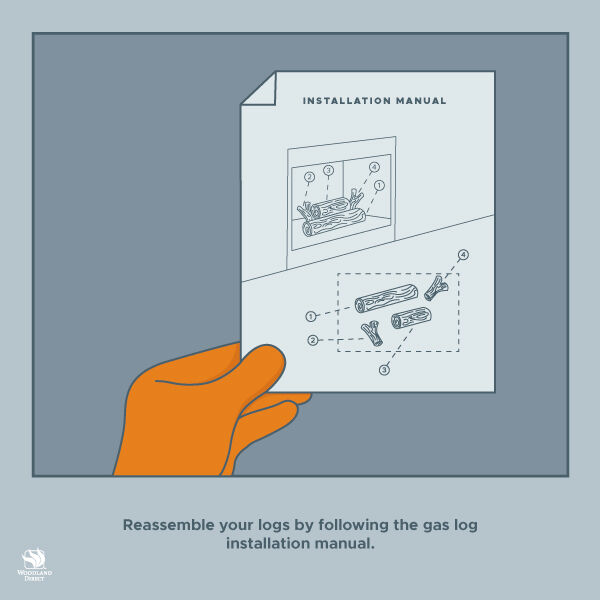
Step 5: Turn Your Gas Supply Back On
Once your log set is properly installed, remember to turn your gas valve back on.
Now, you’re ready to kick back and enjoy a cozy, clean-burning fire!
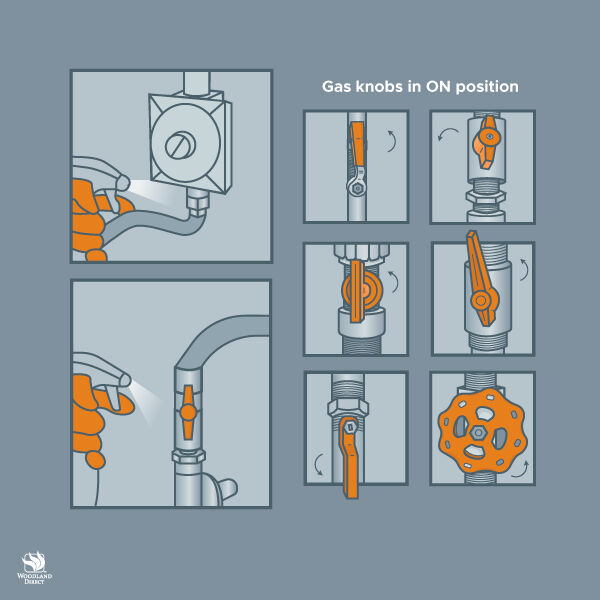
Step 6: Schedule an Inspection
You’ll need to schedule an annual inspection by a certified professional to make sure all your fireplace components, including the gas supply, flue, and venting system, are functioning correctly.
A professional will be able to safely disassemble your gas fireplace components if needed and put them back together correctly.
Reach out to a local NFI-certified professional or a local contractor who has experience servicing and cleaning gas fire features to schedule your annual inspection.

Step 7: Regular Cleaning and Maintenance
Regular gas fireplace maintenance is crucial to protect its appearance and functionality, including wiping down surfaces with a damp cloth and checking for signs of buildup.
Schedule annual maintenance checks to inspect the gas line, gas valve, and pilot light for any issues.
More Tips for Homeowners
💡Safety Precautions: Always ensure the gas fireplace is cool before performing any maintenance. Use protective gloves when handling gas logs to prevent injury.
💡Cleaning Solution: For cleaning glass doors, use a fireplace glass cleaner specifically designed for this purpose to avoid streaks and damage.
💡Wood Burning Fireplaces: If you have a wood fireplace, remember that it requires different maintenance than gas appliances, including chimney cleaning, to prevent creosote buildup.
💡Professional Services: Consider hiring a professional for comprehensive fireplace cleaning and maintenance, especially if you notice signs of gas leaks or carbon monoxide presence.
FAQs
Not exactly. Direct Vent and Ventless gas fireplaces work differently and will require a specific type of log set. For example, Vent-free gas logs are made for approved Ventless systems, while Vented log sets need to be installed in a fully functional firebox with a working chimney. Always check your fireplace type before purchasing.
You can choose from traditional log sets, like oak or birch, or go with more modern designs like driftwood. Leading brands like Grand Canyon Gas Logs, Napoleon, Superior, Empire, and RH Peterson (makers of Real Fyre logs) offer a wide variety of options to match different home styles.
Most gas log sets are compatible with both natural gas and propane configurations. Be sure to check the owner’s manual.
The size depends on the dimensions of your firebox. Measure the height, width, and depth of your fireplace before shopping. Choosing the right size ensures the logs look realistic and your burner system works efficiently.
It depends on the type of gas log set. Vented logs can often be rearranged to achieve a customized look, while Ventless sets must follow a strict placement pattern to prevent direct contact with flames, ensuring proper functionality and safe operation.
We're Here to Help
Have more questions about how to care for your gas log set? We’d love to help! Call our team of NFI certified experts today at 800.919.1904.
More Resources
Find a log set that adds the perfect finishing touch to your gas fireplace with our Gas Log Buying Guide.
Follow this simple guide to safely install your new gas log set.
Learn the key differences between Vented and Ventless gas logs to determine the best option for your home.
 |
Thomas Regis has been a Technical Sales Representative at Woodland Direct for four years. An NFI-Certified expert, Thomas effortlessly directs his clients toward the perfect products, offering essential installation and safety advice. He's tackled projects of all sizes, from backyard fire pits to custom indoor fireplaces. He has even helped Amy Adams, owner of the Tennessee Titans, find a new fireplace for her home! Beyond his professional achievements, Thomas actively participates in community service projects and enjoys spending time on the basketball court. Call him or one of our experts in fire at 800.919.1904. |
